One of the most famous casino games, Blackjack, also known as 21, has grown in popularity all across the globe. It remains one of the most popular casino card games and is available in almost all land-based and online casinos. The humble game of Blackjack has come a long way from being played at land-based tables to live dealer Blackjack on-screen. The history of Live Blackjack may not be that long, but it sure has a lot of fans and has cast its magic over Blackjack lovers.
It is a card game synonymous with one or more players and a dealer. Each player, in turn, competes against the dealer, and not against each other. Blackjack is played with 52 cards of an individual or extra decks, and it is the world’s most commonly played casino banking game. You can try the game at a trustworthy site like Winissimo which provides the game in live dealer forms too.
Equipment required
A regular international deck of cards with the jokers removed is used to play 21 or Blackjack. The game was initially played with only a single deck. However, casinos have implemented multi-deck games as a countermeasure to card-counting, relying on the mistaken belief that if there were more cards in play, it would be difficult to keep track of them by the card counter.
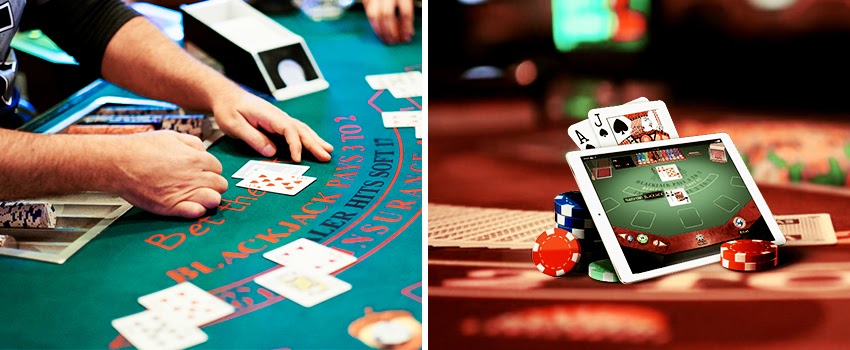
As a consequence, Blackjack is available in versions of either single deck, double deck, 4-deck, 6-deck or 8-deck. In online/live casinos, however, it should be remembered that there are exceptions as much greater numbers of decks can be used than any offline casino.
In addition to the cards, a table, chips, a discard tray, a cut card and a shoe are required for the game in an offline setting. But to play online Blackjack you don’t need anything except for a device to play on, a stable internet connection and your bankroll.
Values of Card
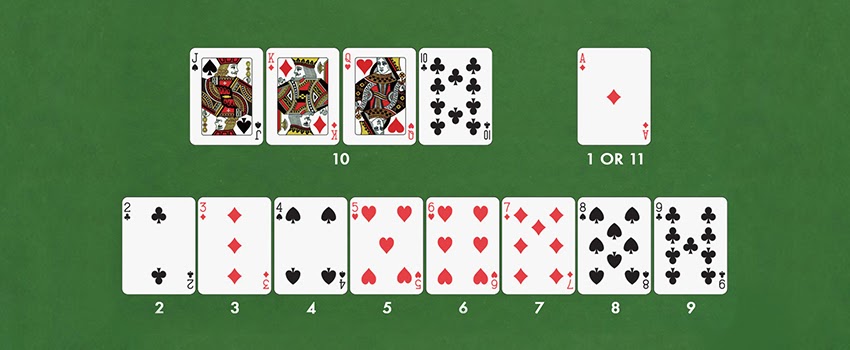
Numeral cards 2 to 10 have their face values when playing Blackjack. Jacks, Queens and Kings are valued at 10, and Aces may have a value of either 1 or 11. Unless the hand is going over 21, the Ace is always valued at 11, in which case it is valued as 1.
A ‘soft’ hand is any hand with an Ace valued as 11. The other hands are considered ‘hard’ hands. A 10-value card and an Ace as a starting hand is considered a Blackjack or natural and defeats all hands except another Blackjack. The outcome is a push (tie) if both the player and the dealer have Blackjack. In this case, neither the house nor the player wins and the bet is given back to the player.
Order of play and options for playing
- Let us see how to play Blackjack. Each player sitting at the table puts their preferred bet right in front of them in the betting circle. If there are untaken betting circles in most casinos, players seated at the table can opt to play more than one hand at a time.
- The minimum and maximum bet size, normally with a ratio of 40 to 100 between them, vary from casino to casino. For a minimum $25 bet, for example, the maximum would typically be anywhere from $1000 to $2500.
- The dealer will move their hand over the table from their left to their right, signalling that no more bets will be made. One at a time in a clockwise direction, from his left to his right, the dealer then deals out cards around the table.
- First, a card with its face-up is dealt to each betting circle that has a bet in it and to the dealer. After that, a second card with face-up is dealt with each betting circle with a bet and a second card with face-down is dealt to the dealer.
- The dealer’s first card is originally circulated face down at several locations. The second card of the dealer is used to turn the first card face up and then slide under the first card. As determined by the casino administration, the exact dealing procedure is decided and hence it varies from place to place.
- The choice of making an insurance bet is given if the dealer has a 10 or an Ace face-up card. Insurance is a side gamble on whether the dealer has a Blackjack or not, irrelevant to the round’s final result. If a player wishes to take this side bet, an extra bet equal to half of their initial bet would be placed. If the dealer has the Blackjack, this insurance gamble wins.
- Now the dealer tests their down card to see if they have got a Blackjack. If they have Blackjack, the down card will be revealed. The round is completed and unless they already have Blackjack, all the players forfeit their initial bet. The result is a push(tie) and the player’s bet is returned if he and the dealer both have Blackjack. All insurance bets are paid out at 2:1.
- Any insurance bets are lost if the dealer does not have Blackjack and the players who have Blackjack are compensated.
Then, it is the turn of the remaining players to make decisions. They have the following options, starting with the player sitting furthest to the left of the dealer:
Stand
If the player is satisfied with the sum they have been dealt, they will stand, take no further action and move on to the next player.
- After any of the other player’s actions, the player can choose to stand as long as their hand number is not more than 21.
- The Stand hand signal is waving a flat hand over the cards.
Hit
- If the player needs to take another card, they can signal the dealer by scratching the felt next to their hand or pointing their hand.
- A single card is then played with face up.
- If the hand sum is less than 21, the player may opt to hit or stand again.
- The hand would automatically stand if the sum is 21.
- If the sum is over 21, the hand is bust, the house takes the player’s bet and the turn to act goes to the next player.
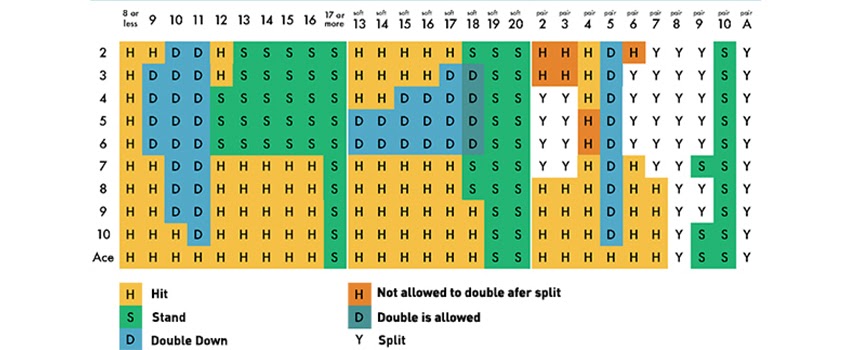
Double Down
- The player can opt to ‘Double Down‘ if he/she feels that they have a favourable hand, normally a total of 9, 10 or 11.
- To do this, they put a second wager equal to their first.
- A player who doubles down gets exactly one more face-up card and is then forced to stand irrespective of the sum.
- This choice is valid on the starting two-card hand of the player only. Any casinos can limit the number of starting hand-totals that can be doubled.
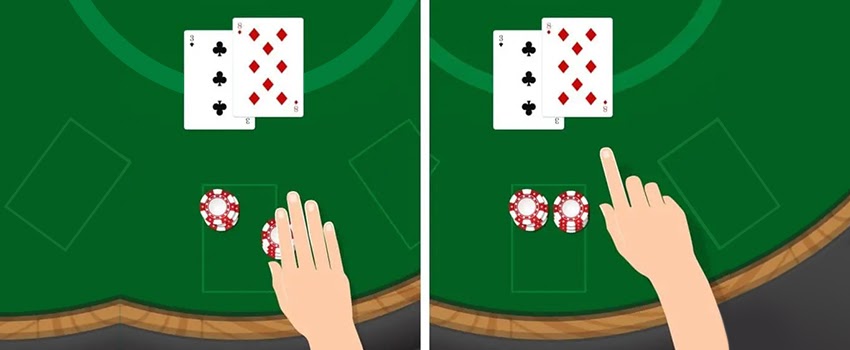
Split
- They can choose to place an extra bet equal to their original bet and split the cards into two hands if the player’s first two cards are of matching rank.
- The cards are divided if the player wishes to do this and an extra card is allocated to complete each hand.
- The player could be given the option to split again if either hand receives a second card of matching rank, but this depends on the casino rules.
- Generally, a limit of 4 hands is permitted for the player, in which no more breaks are allowed.
- The split hands are played one by one starting from the dealer’s left to the dealer’s right, in the sequence in which they have been dealt.
- All the normal choices are open to the player: hit, stand or double down.
- Some casinos restrict the card ranks that may be split and after splitting a pair, may even limit the option to double.
- Usually, a player who splits Aces is only permitted to receive a single extra card on each hand. Players are usually permitted to split two non-matching 10-value cards, such as a King and a Jack.
- Some casinos, however, limit the division of 10 value cards to pairs of the same rank (two Jacks for instance).
- In any case, it should be remembered that splitting 10s is almost always a bad move for the player. The resulting hand does not count as a Blackjack, but rather as an ordinary 21 when Aces are split and the player draws a 10 or even if 10s are split and the player draws an Ace. The two-card 21 of the player will force a tie with the 21 of the dealer in 3 or more cards in this situation.
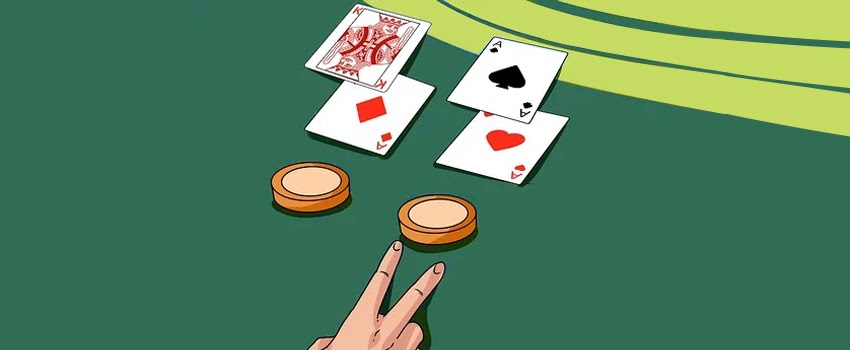
Surrender
- Some casinos make it easy for a player to surrender, take back half their bet and give up their hand.
- Surrender must be the last move on the hand of a player.
- This is done after the dealer has tested the hole card in the most popular variant, known as Late Surrender, and doesn’t have a Blackjack.
- Offering the surrender alternative has become exceedingly unusual for casinos.
- The dealer plays their hand according to set rules until both players have completed their acts.
- They’ll show the down card first. Until they have a limit of 17 or more the dealer can then resume taking cards. The Soft 17 rules (a total of 17 with an Ace counted as 11 such as A+6) differ from casino to casino. Some need the dealer to stand, while others need to take extra cards before a difficult 17 or 18+ total is achieved. This law will be written on the felt of the table.
- All non-busted player hands are automatically losers until the dealer busts them.
- All non-busted player hands are natural winners if the dealer busts.
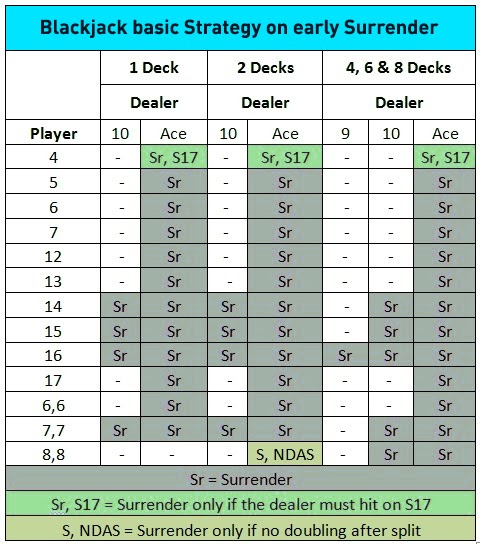
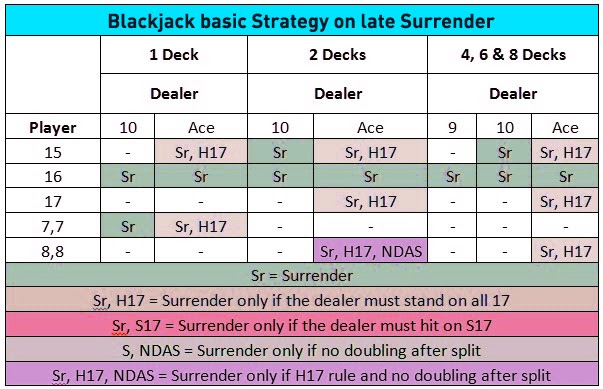
Payouts
- The hand is called a push and the player’s bet is returned if the player and dealer have similar unbusted totals.
- When a player wins a hand, the cumulative bet wagered on that hand is paid out at 1:1.
- Bets are paid at 3: 2 if the player has a Blackjack.
- If the insurance bet is made by the player and the dealer has Blackjack, the hand of the player fails, but the insurance bet is paid at 2:1.
Why should you follow a Blackjack strategy for betting?
All players are in this position someday or the other. Since losing your first hands online, you all must have searched for the safest and most efficient Blackjack strategy to succeed at.
It is possible to maximize the Blackjack odds of winning with a proper Blackjack strategy and that is because Blackjack isn’t like Roulette, video Poker, or slots. If you follow the simple Blackjack strategy approach and understand how to use the info you have on your hands, you can achieve optimum play, offering yourself the best opportunity in the game to succeed.
Skilled players have been working tirelessly to ‘solve’ the Blackjack game and figure out how to play each hand to get the best chances of winning. They have studied how the number of decks in play determines the odds of winning and how you can make the right decision depending on the cards you get dealt at the table.

This is what they call the basic Blackjack strategy. A list of dos and don’ts where you find out how every hand you are dealt with is intended to play. This is the ultimate Blackjack strategy.
The purpose of the basic rules of Blackjack strategy is not to help you win every time you play Blackjack. It’s unlikely, that. Rather, it is to help you increase your odds of winning and to mitigate your losses. That is the purpose of this article as well. We may not mention any of the Blackjack strategy techniques out there. Instead, we will concentrate only on the best tactics for Blackjack that are proven to perform and can help you get better outcomes when you play.
Read this until you get some maps memorised
- The basic blackjack strategy is not adequate.
- The simple technique will not conquer the edge of the house even though you get lucky from time to time with it. Think of it as a shuttle in orbit. The rocket booster is just the basic solution. It takes the spacecraft far enough in the atmosphere to do the majority of the job for the shuttle. The rocket booster would never enter orbit. To beat the Blackjack game, you will need card-counting, deviations, true count conversions and betting technique, but that’s for later.
Important Factors To Keep In Mind

|
The basic Blackjack strategy has an operations order:
Shall I/can I surrender?
You will only have the option to surrender on the first two cards you are dealt if you are playing at a casino that provides surrender. If you have already taken a hit card, you may not be allowed to surrender. This is why the first thing that you have to think about while playing your hand is surrender. You should ask yourself if the response is no you cannot or no you should not surrender.
May I/should I split?
Whether or not to split is the second most significant decision. This would only be an option if the first 2 cards are a pair or if you have two cards of 10 values (like a jack and a king). Assess your step if the answer is no you can’t or you shouldn’t split.
Will I/should I double up?
This is a very good thing because the basic Blackjack strategy approach calls for doubling. It means that you are likely to win that hand! Some casinos limit doubling on hands, so it might not always be possible, but before you go on, you should make sure that you have ruled it out.
Am I meant to hit or stand?
When it comes to a simple Blackjack strategy, the last thing you can care about is whether or not to pick up another card. If your hand is not ideal for the other alternatives then you can always choose to hit or stand.
The basic Blackjack strategy in some simple phrases
These simple phrases could help you commit these rules to memory if you are not a visual learner. The purpose of recalling phrases is to be able to look at the whole hand and recite the rule in your mind automatically, without having to see what the dealer has. That way, you already know how it corresponds to your hand when you are at the table, you look up to see what the dealer has, and you can make your choice in a split second. It would make it much easier to memorise these to make fewer errors.
Surrender
- Dealer 9 through Ace – 16 surrenders, or else don’t surrender (revert to hard totals).
- Dealer 10 – 15 surrenders, otherwise don’t surrender (revert to hard totals).
Splits
- Split aces always.
- Tens are never split.
- Except for 7, a pair of 9’s splits against dealer 2 through 9, otherwise stand.
- Split 8’s always
- A pair of 7s splits, otherwise hit, 2 through 7 against the dealer.
- A pair of 6s splits, otherwise hit, 2 through 6 against the dealer.
- A pair of 5s splits, otherwise hit, 2 through 9 against the dealer.
- A pair of 4s splits, otherwise hit, 5 and 6 against the dealer.
- A pair of 3s splits, otherwise hit, against dealer 2 through 7.
- A pair of 2’s splits, otherwise hit, against dealer 2 through 7.
Soft totals
Every hand that has an Ace as one of the first two cards is soft: the ace is counted as 11 to start.
- Soft 20 (A,9) – will always stand.
- Soft 19 (A,8) – doubles against dealer 6, stands otherwise.
- Soft 18 (A,7) – doubles, against the dealer 2 through 6, and hits against 9 through ace, stands otherwise.
- Soft 17 (A,6) – doubles, otherwise hit, against dealer 3 through 6.
- Soft 16 (A,5) – doubles, otherwise hit, against dealer 4 through 6.
- Soft 15 (A,4) – doubles, otherwise hit, against dealer 4 through 6.
- Soft 14 (A,3) – doubles, otherwise hit, against dealer 5 through 6.
- Soft 13 (A,2) – doubles, otherwise hit, against dealer 5 through 6.
Hard totals
Any hand that does not start with an ace or an ace that can only be considered as 1 instead of 11 has been dealt, is a hard total.
- 17 and up, stands at all stages.
- 16 stands, otherwise hit, against dealer 2 through 6.
- 15 stands, otherwise hit, against dealer 2 through 6.
- 14 stands, otherwise hit, against dealer 2 through 6.
- 13 stands, otherwise hit, against Dealer 2 through 6.
- 12 stands 4 through 6 against the dealer, otherwise hit.
- 11 will always double.
- 10 doubles, otherwise hit, against dealer 2 through 9.
- 9 doubles, otherwise hit, against dealer 3 through 6.
- 8 hits at all times.
Advanced Blackjack strategy – Card Counting
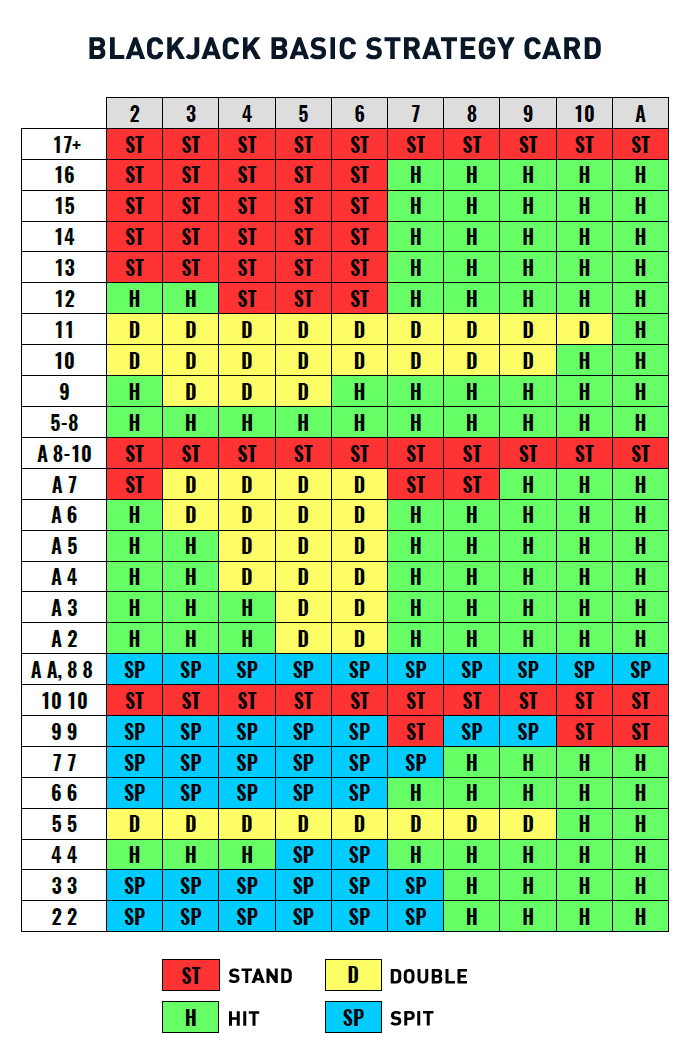
Card counting gives the player a mathematically validated chance to obtain an edge over the house. It must be noted that this does not mean the player is going to win. Much as a normal player can gain good luck despite playing at a disadvantage, it is perfectly possible for the card counter to have bad luck over an extended time, even if playing with a slight advantage over the house.
- The fundamental principle of card counting is that low cards are favourable to the dealer on average, mathematically speaking, while high cards benefit the player. There are several subtle explanations, but the most critical ones are:
- A player getting a Blackjack is compensated one and a half times their bet (a ten worth card and an Ace-two high card). However, when dealt a Blackjack, the dealer only earns the player’s bet.
- Although at any point the player will avoid taking extra cards, rules mandate the dealer to continue drawing cards until they attain 17 in total. For a total of 16, the player can choose whether to take an extra card or not, while the dealer has to take one. In this scenario, small cards are less likely to induce the dealer to bust, since they favour the dealer, while big cards cause the dealer to bust more often and prove to be an advantage to the player.
- The majority of cases where the player is right to double are starting hands that can be made very good by adding a 10 worth card or an Ace. Thus, when there are more 10 worth cards and Aces left on the table, doubling becomes more favourable.
So a Card Counter searches at moments where more cards are left to be played than a normal deck would have. The Card Counter will typically use a ratio scheme instead of having to recall every card that has been played, which offsets cards that are better for the player against cards that are better for the dealer.
The most commonly used Card Counting system is the HiLo count, which values cards as follows:
| High cards: 10, J, Q, K, A: | -1 |
| Medium cards: 7, 8, 9: | 0 |
| Low cards: 2, 3, 4, 5, 6: | +1 |
- The player begins at zero to keep count, adds 1 to the total if a low card is played and subtracts 1 from the total when a high card is played. This is the ‘Running Count’. Subtracting 1 for high-value cards that are beneficial for the player may sound counterintuitive, but a high card played is one less high card left to be played. The player realizes that there are more player-friendly cards available to be played if the Running Count is positive.
- The running count would start at 0 when properly kept and, if all the cards were to be played out, it would finish at 0. This is because high cards and low cards are in equal numbers. Therefore the HiLo count is considered a ‘Balanced Counting System’.
- In general, card counting schemes are not impeded by several decks being applied to the table. At any rate, multiple decks do not make it substantially more difficult for the Card Counter to keep track of the Running Count, because the Running Count is a single number, and needs to be monitored by the Card Counter. However, with many decks being used, the count starts at zero and if no cards are remaining, the count will stop at zero, so no adjustments to the counting method need to be made.
- Where many decks make a difference is how much a positive Running Count affects the benefit of the player. If the Running Count is +10 and 2 decks remain to be played, this indicates that in each deck there are an additional 5 advantageous cards for players. There are only 2 additional player-favourable cards in each set if there are 5 decks left to be played. The higher the concentration of extra player advantageous cards, the greater the benefit of the player.
- Therefore, the running count has to be divided by the number of decks left to be played to determine the strength of the player advantage. This number is called the True Count.
- The player has a consistent calculation of how many additional desirable cards are found inside the remaining cards, with the True Count. This data can be used by the player to vary their betting and playing strategy. If the True Count is high and low bets (or ideally nothing) when the True Count is small or unfavourable, variations from Basic Blackjack Strategy are much less important than putting big bets.
- It is important to remember that for your long-term success as a card counter you need to accurately size your bet. This includes considerable external experience and insight into this dynamic feature of card counting.
Card counting in online Blackjack
- In general, card counting is effective only in land-based casinos, not in online Blackjack. The plan depends on the game providing a “memory” in which cards are allocated from the remaining cards after previous rounds have been played. Online Blackjack games are controlled by a computer and typically use an RNG after each round of play to shuffle the whole deck. Games of this type cannot be counted.
- There are several online Live Blackjack tournaments, which are played by a human dealer through a video stream. Technically, these may be counted, but card-counting could also be hard to do here. Each player betting and all cards dealt are registered by the casino’s software. This makes it reasonably easy for a casino to use apps to track the count and watch the players raise their bets or just play while the count is favourable.
- Card counting has not become popular online for the aforementioned purposes.
Is card counting legal?
Unless counting machines or systems are used, card counting is not cheating. It remains legitimate, despite the numerous efforts by casinos to get laws passed that criminalise it. This suggests that it is not illegitimate to win a card game by using a mental plan or skillfully exploiting the knowledge you have. No one should ever deter you from counting the cards in your brain!
The next steps
You would still need to understand what count indices you need to deviate from the basic Blackjack strategy chart until you have memorised the basic strategy chart completely. Deviations differ depending on the rules of the provided game and also the rules of the region where you are playing. Good luck!


